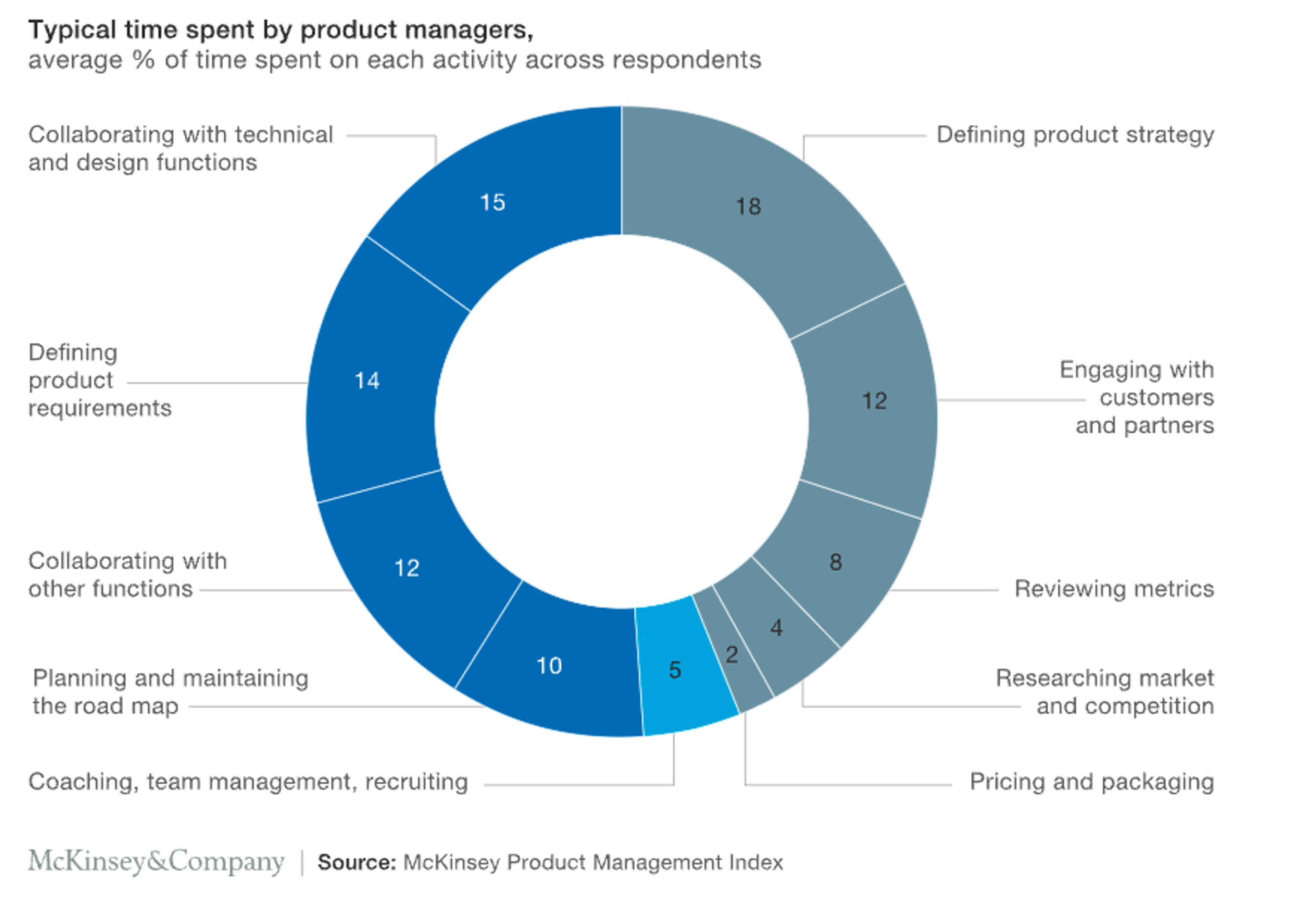The 20 Most Important Product Manager Skills
Discover the 20 most important product manager skills that drive success. From leadership and communication to data analysis, learn the key competencies every PM needs to excel.
Posted June 13, 2025

Join a free event
Learn from top coaches and industry experts in live, interactive sessions you can join for free.
Table of Contents
Welcome to the product manager role.
As a product manager, you're the bridge between big ideas and their execution, ensuring that the product vision remains clear and that every step of the process runs smoothly. You're the one who keeps the team aligned and on track, making it a demanding yet highly rewarding role that requires both leadership and collaboration. To truly thrive in product management, you’ll need a diverse skill set, from market insight and data analysis to team management and effective decision-making. This article explores 20 essential skills every product manager should master, offering practical tips to help you grow -- whether you're just beginning your journey or honing your expertise. Let’s get started!
What Does a Product Manager Do?
A product manager is responsible for guiding the success of a product from concept to launch and beyond. They serve as the bridge between different teams—such as engineering, design, marketing, and sales—ensuring that the product aligns with both user needs and business goals. Product managers define the product vision, prioritize features, manage the roadmap, and make data-driven decisions to create value for users while driving business outcomes. In essence, a product manager ensures that the right product is built, and that it reaches the market successfully, meeting both customer expectations and company objectives.
20 Must-Have Product Management Skills
Now that you know what a PM does, let’s go through some of the most important product manager skills that differentiate mediocre from great PMs. We’ve categorized them into three buckets: Leadership & Interpersonal Skills, Strategic & Analytical Skills, and Technical & Product-Specific Skills.
Leadership & Interpersonal Skills
- Communication
- Leadership
- Stakeholder Management
- Emotional Intelligence
- Cross-Functional Collaboration
- Negotiation Skills
Strategic & Analytical Skills
- Strategic Thinking
- Business Acumen
- Market Research
- Data Analysis
- Product Analytics
- Prioritization
- Problem-Solving
- Adaptability
Product-Specific and Technical Skills
- Technical Proficiency
- UX Design Principles
- Prototyping
- Machine Learning Basics
- Product Roadmapping
- Agile Methodologies
1. Communication
Communication is one of the most critical soft product manager skills. In this role, you need to excel in both verbal and written communication to convey ideas, decisions, and product goals clearly. Effective communication skills ensure alignment among teams, stakeholders, and customers, driving the product toward success. Product managers act as the central hub for cross-functional teams, making it essential to share the product strategy and vision in a way that everyone understands and supports.
Verbal Communication: Mastering verbal communication is crucial for product managers. Whether you're presenting ideas, leading meetings, or negotiating with stakeholders, strong verbal communication builds trust and clarity. To improve, practice active listening and tailor your message to your audience. It's not just about speaking—it's about ensuring your words foster understanding and collaboration.
Written Communication: In the digital age, clear written communication is also essential. Product managers must craft concise emails, detailed product requirements, and strategy documents. Focus on being thorough yet succinct, using simple language to avoid confusion. Writing effectively ensures that everyone, from engineers to executives, can easily grasp your message and stay aligned on product goals.
Presentation Skills: You will frequently present to various audiences, from executives to development teams. Strong presentation skills help you convey complex ideas with ease. To enhance your presentations, practice storytelling techniques, incorporate visual aids, and rehearse your delivery. Be prepared to answer questions confidently and maintain engagement throughout.
2. Leadership
Product managers need to be able to guide teams, align stakeholders, and drive the overall product vision. Product management is highly cross-functional and PMs also frequently have to work with execs and other senior employees. Effective leadership helps foster collaboration, resolve conflicts, and ensure everyone is working towards common goals.
Why is Leadership Important?
Leadership allows product managers to inspire and motivate their teams, ensuring that everyone is aligned and focused on achieving the product vision. Strong leadership skills help you build trust with your team and stakeholders, leading to smoother collaboration and more effective decision-making.
Leadership Techniques
- Build trust within your team: Practice active listening and involve team members in the decision-making process. Give them ownership over certain aspects of the roadmap to foster collaboration and accountability.
- Engage stakeholders early: Proactively manage stakeholders by setting clear expectations and regularly updating them on progress. Ensure they feel heard and involved, which helps build strong relationships and buy-in for your product vision.
- Resolve conflicts calmly: When conflicts arise, focus on understanding the root cause and finding long-term solutions. Acknowledge all concerns, seek common ground, and guide the conversation toward resolution.
3. Stakeholder Management
Effective stakeholder management is key to building strong relationships and ensuring alignment with the broader business goals. This skill helps product managers navigate the interests and expectations of different teams and individuals across the company.
Why is Stakeholder Management Important?
Stakeholder management ensures that all parties involved in product development—whether internal or external—are aligned and supportive of the product’s goals. It helps avoid misunderstandings and ensures smooth collaboration.
Stakeholder Management Techniques
- Map stakeholders: Identify key stakeholders and understand their needs, influence, and expectations. Use stakeholder mapping to prioritize how and when to engage them.
- Set clear expectations: Establish clear communication channels and set expectations early. Regularly update stakeholders on progress, changes, and challenges.
- Use data in conversations: When communicating with stakeholders, support your recommendations with data to gain trust and make more convincing arguments.
4. User Empathy
User empathy is one of the most important product management skills, involving a deep understanding of the user's perspective. It’s about experiencing the world as your users do—their challenges, joys, and routines—so you can create products that truly resonate with them. You can build any product, but if users won’t actually find value from it, then there’s no point.
Why is User Empathy Important?
User empathy ensures that product managers can create solutions that address real-world problems faced by the end users. By understanding the pain points and needs of your audience, you’re better equipped to design products that not only meet business objectives but also deliver value to customers. Empathy helps bridge the gap between what users need and what the business provides, creating more meaningful, user-friendly products.
User Empathy Techniques
1. Understand user needs: Go beyond basic demographics when researching your users. Create detailed user personas that capture their daily routines, challenges, and interactions with technology. This detailed approach will help you design solutions that target genuine pain points.
2. Conduct user research:
- Shadow users in real-life environments to observe how they interact with your product or potential solutions.
- Create empathy maps that capture emotions, thoughts, and behaviors to better understand user motivations.
- Conduct in-depth interviews with users, aiming for rich, qualitative data that reveals their true challenges and desires. User feedback is one of the most valuable sources of information for product management.
3. Apply user insights:
- Use insights to prioritize features that address user pain points effectively.
- Conduct usability tests to validate design decisions, ensuring that user needs are met.
- Tailor marketing campaigns to user segments based on their challenges and expectations, ensuring your messaging resonates.
Bonus: Emotional Intelligence
Emotional intelligence is the ability to recognize and manage your own emotions, as well as those of others. This skill is especially important for product managers who need to build trust and foster collaboration across diverse teams.
Why is Emotional Intelligence Important?
Emotional intelligence enables a product manager to navigate interpersonal dynamics, resolve conflicts, and build a positive, collaborative team culture. It also helps in understanding the emotions and motivations behind customer feedback.
Emotional Intelligence Techniques
- Practice empathy: Actively listen to team members and customers. Recognize and acknowledge their emotions to build stronger relationships and resolve conflicts effectively.
- Manage stress and emotions: Stay calm under pressure and develop coping mechanisms to maintain focus during difficult situations. Emotional control ensures that you can think clearly and make sound decisions.
- Encourage open feedback: Foster an environment where team members feel comfortable sharing concerns and feedback. This helps you address issues before they escalate.
5. Cross-Functional Collaboration
Cross-functional collaboration is absolutely key to being a successful product manager. Product management is all about working with teams across engineering, design, marketing, and more to deliver a successful product. Seamless collaboration ensures alignment, smooth product development, and effective problem-solving.
Why is Cross-Functional Collaboration Important?
Successful product development requires input and alignment from various teams. Effective collaboration helps ensure that everyone is working toward the same goals and that technical, design, and business considerations are balanced throughout the product lifecycle.
Collaboration Techniques
- Work effectively with engineering: Respect the engineering team’s “maker schedule” by avoiding interruptions during focused work time. Familiarize yourself with the technical constraints of the product to make informed decisions.
- Collaborate closely with design: Involve designers early in the process and be open to their creative ideas. Hold regular feedback sessions to ensure user experience is a central focus of product development.
- Align with marketing: Ensure that marketing teams understand key product features and value propositions. Collaborate on launch strategies and gather customer feedback to inform future product iterations.

6. Negotiation Skills
Negotiation is a vital skill for every product manager, whether you're working with stakeholders, internal teams, or external partners. Effective negotiation helps build consensus, resolve conflicts, and ensure product development stays aligned with both business objectives and user needs. Anyone in product management is required to work with a lot of different teams – teams that, usually, have competing priorities and goals. Negotiation is how you make sure that everyone gets on board with what’s best for the company as a whole.
Why are Negotiation Skills Important?
Negotiation allows product managers to advocate for their product’s needs while balancing the interests of stakeholders, engineering teams, and customers. It is key to securing necessary resources, managing trade-offs, and driving alignment across teams.
Negotiation Techniques
- Align goals in stakeholder negotiations: Focus on understanding underlying interests rather than just stated positions. Present data-backed arguments to keep negotiations fact-based and avoid emotional bias.
- Use a BATNA in vendor negotiations: Have a backup plan (Best Alternative to a Negotiated Agreement) to maintain leverage during negotiations with vendors. This ensures you have alternatives if the negotiation doesn’t go as planned.
- Be collaborative in feature negotiations: Balance technical debt, stakeholder expectations, and user needs. Use objective criteria and frameworks to assess options, maintaining positive relationships while achieving the best outcomes.
For additional product management resources, you may find the following articles helpful:
- 20+ Free Product Management Resources
- Preparing for Your Product Manager Behavioral Interview: Tips and Strategies
- What Is a Product Lead and Why Is It So Important?
7. Strategic Thinking

Strategic thinking is one of the most important product management skills because it allows product managers to see the big picture and plan for long-term success. It involves analyzing market trends and setting future goals that align with the product vision. A product manager's ability to think strategically helps them make decisions that not only address immediate challenges but also unlock valuable future opportunities. This approach ensures that each choice supports both the product's current needs and its broader, long-term potential in the market.
Why is Strategic Thinking Important?
The importance of strategic thinking in product management can't be overstated. It helps you make good decisions that balance risk and reward. By thinking strategically, you can prioritize effectively, shape product roadmaps, and align your team's efforts with overarching business goals.
Strategic Thinking Techniques
- Analyze past successes and failures: Review previous product decisions to understand what worked and what didn’t. This helps you recognize patterns and make more informed choices in future strategy planning. Use post-mortems and case studies to analyze outcomes and identify lessons learned.
- Balance risk and reward: When making decisions, consider the potential impact and probability of success. Weigh short-term risks against long-term rewards to ensure you are prioritizing initiatives that will provide the highest value for the product and business.
- Visualize potential outcomes: Use tools like outcome trees or decision matrices to map out different scenarios. This will help you understand the possible consequences of each decision, allowing you to make more thoughtful, future-oriented choices.
- Incorporate regular brainstorming sessions: Set aside time for unstructured brainstorming sessions with your team to explore new ideas and approaches. This encourages creative thinking and helps generate fresh solutions that align with long-term product goals.
- Engage stakeholders in strategy discussions: Schedule regular strategy meetings with stakeholders to ensure alignment and gather different perspectives. Open communication with key stakeholders will help you refine your product strategy and ensure it aligns with broader business objectives.
8. Business Acumen
Product managers are mostly focused on building, but business acumen is important because it allows them to understand how their product contributes to the company’s financial health and strategic goals. Depending on the role and size of the company, small product changes can have major effects on the bottom line so it’s important to at least understand the basics. It includes financial literacy, business model understanding, and a focus on revenue generation.
Why is Business Acumen Important?
Business acumen helps product managers make decisions that align with the company's financial and strategic goals. It ensures that products are not only valuable to users but also contribute to the overall profitability and sustainability of the business.
Business Acumen Techniques
- Understand key financial metrics: Familiarize yourself with metrics like customer acquisition cost (CAC), return on investment (ROI), and free cash flow. These numbers help you prioritize features and assess the financial viability of product initiatives.
- Know your business model: Be able to articulate how your product creates value for the business. Whether your company operates on a subscription model, freemium model, or marketplace, understanding this framework allows you to make more informed product decisions.
- Focus on revenue streams: Identify and optimize revenue-generating opportunities within your product, such as developing pricing strategies or upselling features that increase customer lifetime value (CLV).
Here is a general list of business acumen topics that every product manager should know; note that these will vary depending on your role, level of seniority, company, and other factors.
- Revenue & Profitability
- Revenue models (subscription, freemium, transactional)
- Profit margins
- Customer Acquisition Cost (CAC)
- Customer Lifetime Value (CLV)
- Return on Investment (ROI)
- Business Models
- SaaS (Software as a Service) models
- B2B vs. B2C models
- Marketplace models
- Direct-to-consumer (D2C) models
- Pricing Strategy
- Value-based pricing
- Tiered pricing models
- Dynamic pricing strategies
- Monetization of free products
- Market Analysis & Sizing
- Market sizing (TAM, SAM, SOM)
- Competitor analysis
- Customer segmentation and targeting
- Identifying emerging trends and market shifts
- Product-Market Fit
- Value proposition creation and differentiation
- Customer value mapping
- Competitive advantage and positioning
- Go-to-Market Strategy
- Product positioning and messaging
- Sales enablement and alignment with marketing
- Distribution channels and customer acquisition
- Strategic Alignment
- Aligning product roadmaps with business objectives
- Long-term vs. short-term strategy balancing
- OKRs (Objectives and Key Results)
- Risk Management
- Identifying market risks and mitigation strategies
- Financial risks (cost overruns, revenue fluctuations)
- Operational Efficiency
- Resource allocation and cost optimization
- Scalability and operational planning
- Financial Literacy
- Understanding key metrics like free cash flow, gross margin, and financial forecasting
- Budget management for product development
9. Market Research
Market research is one of the more underappreciated product management skills, as it enables product managers to gather and analyze data about their target market, customer needs, and competitive landscape. This research helps product managers make informed decisions about product positioning, pricing, and market opportunities.
Why is Market Research Important?
Market research allows product managers to understand their audience and the competitive landscape, helping to shape the product strategy. It ensures that decisions are based on data and customer insights rather than assumptions, leading to better product-market fit and long-term success.
Market Research Techniques
1. Analyze competitors effectively: Conduct a competitor analysis to understand their strengths and weaknesses. Identify gaps in their product offerings that could be opportunities for differentiation.
2. Track industry trends: Stay updated on market trends by reading industry reports, attending conferences, and following thought leaders. This helps you anticipate shifts in customer needs and adjust your product strategy accordingly.
Read: The Best Newsletters & Podcasts for Product Management
3. Conduct market sizing: Estimate the size and growth potential of your target market. Use this data to evaluate whether a product idea is viable and worth pursuing.
10. Data Analysis
Data analysis is a core product management skill because it enables informed decision-making. It involves collecting, interpreting, and using data to drive product development and product strategy, helping you to build data-driven products that succeed in the market.
Why is Data Analysis Important?
Data analysis is crucial because it empowers product managers to make informed decisions backed by quantitative evidence. Instead of relying on assumptions, you can leverage data to understand user behavior, validate product features, and optimize strategies. With solid data analysis, you can confidently guide product direction, track progress, and achieve better business outcomes.
Data Analysis Techniques
- Track user analytics: Familiarize yourself with platforms like Google Analytics and Mixpanel to identify trends in user behavior. These tools help you track metrics like daily active users (DAU), session duration, and conversion rates, all of which inform product decisions.
- Get very comfortable with A/B testing: Master A/B testing to compare different versions of product features. By evaluating how each version impacts user engagement or conversion rates, you can determine which feature performs better and make data-driven improvements.
- Learn the basics of financial analysis: Develop financial analysis skills to understand key metrics such as ROI, cost-benefit analysis, and pricing strategies. These skills are critical for assessing the financial viability of your product and ensuring it aligns with company goals.
- Track key performance indicators: Define and track key performance indicators (KPIs) that measure the success of your product, such as user growth, retention rates, or customer satisfaction. Consistently monitoring these metrics helps you identify areas for improvement and track product performance over time.
11. Product Analytics
Product analytics is essential for making data-driven decisions and product managers make tons of decisions. It also helps track product performance, understand user behavior, and identify areas for improvement. Key metrics like Daily Active Users (DAU) and Customer Acquisition Cost (CAC) provide insight into your product’s health and help you with roadmapping, prioritization, and many other day-to-day tasks.
Product analytics is essential for making data-driven decisions and product managers make tons of decisions. It also helps track product performance, understand user behavior, and identify areas for improvement. Key metrics like Daily Active Users (DAU) and Customer Acquisition Cost (CAC) provide insight into your product’s health and help you with roadmapping, prioritization, and many other day-to-day tasks.
Why is Product Analytics Important?
Product analytics helps product managers make informed decisions based on real data. It allows you to measure the success of your product, understand what’s working, and identify areas that need improvement. Data-driven decision-making leads to more effective product strategies and better results.
Product Analytics Techniques
- Track key metrics: Focus on tracking important metrics such as DAU, Monthly Active Users (MAU), and Net Promoter Score (NPS). These metrics help assess user engagement, satisfaction, and product health.
- Use the right analytics tools: Familiarize yourself with tools like Google Analytics, Mixpanel, and Amplitude. Use these platforms to perform funnel analysis, cohort analysis, and track user journeys.
- Monitor performance regularly: Regularly analyze performance data to spot trends, identify friction points, and make data-driven decisions about future feature development.
Here are some of the more common product analytics metrics:
- Daily Active Users (DAU) – The number of unique users who engage with the product on a daily basis.
- Monthly Active Users (MAU) – The number of unique users who engage with the product on a monthly basis.
- Customer Acquisition Cost (CAC) – The cost associated with acquiring a new customer, including marketing and sales expenses.
- Customer Lifetime Value (CLV or LTV) – The total revenue expected from a customer over the duration of their relationship with the product or company.
- Churn Rate – The percentage of users who stop using the product or cancel their subscription over a given period.
- Retention Rate – The percentage of users who continue to use the product over time.
- Conversion Rate – The percentage of users who complete a desired action (e.g., signing up, making a purchase, subscribing) out of the total users.
- Net Promoter Score (NPS) – A measure of customer satisfaction and loyalty based on how likely customers are to recommend the product.
- Average Revenue Per User (ARPU) – The average amount of revenue generated per user over a specific time period.
- Time on Page / Session Duration – The average amount of time users spend engaging with the product or a specific feature.
- Feature Adoption Rate – The percentage of users who have adopted a new feature out of the total number of users exposed to it.
- Funnel Analysis – Tracks user progress through defined stages in the product, highlighting where users drop off or convert.
- Bounce Rate – The percentage of users who leave the product (or a specific page) without taking any meaningful action.
- Customer Satisfaction Score (CSAT) – A metric that measures user satisfaction based on feedback or survey responses about a specific interaction or feature.
- Cohort Retention Analysis – Measures the retention of different groups (or cohorts) of users over time to track how well retention improves after changes.
12. Prioritization
Prioritization skills are the ability to rank and organize features based on customer value, business goals, time, cost, and technical viability. Since product managers control the roadmap, prioritization ensures that the right features are built at the right time, maximizing both customer satisfaction and business impact.
Why is Prioritization Important?
Prioritization skills allow product managers to focus on features that will deliver the most value within the constraints of time, resources, and business needs. It helps prevent feature bloat, ensures alignment with strategic goals, and improves team efficiency by focusing efforts on what matters most.
Prioritization Techniques
1. Try prioritization frameworks:
- RICE Method: Evaluate features based on Reach, Impact, Confidence, and Effort. This framework helps product managers prioritize features that will have the highest overall value with the least effort.
- MoSCoW Method: Categorize features into Must-have, Should-have, Could-have, and Won’t-have to clearly identify priorities and manage expectations.
- Value vs. Effort Matrix: Plot features based on their potential impact and development complexity. This visual tool helps prioritize features that deliver the most value with the least effort.
2. Learn feature prioritization: Start with a goal-first approach. Define measurable objectives that align with your product vision, and use quantifiable metrics to score ideas based on potential value. This approach ensures that decisions are data-driven and can be clearly communicated to stakeholders.
3. Allocate resources effectively: Effective prioritization also involves resource allocation across your product portfolio. Use resource management tools to assess where teams should focus to meet company goals. Monitor time spent on different features, review dependencies, and visualize what-if scenarios to ensure resources are allocated effectively.
13. Problem-Solving
If there is one thing every product manager does on a daily basis, it’s solving problems. From resolving product issues to overcoming obstacles in team collaboration, the ability to identify problems, analyze root causes, and develop effective solutions is essential to ensuring product success.
Why is Problem-Solving Important?
Problem-solving enables product managers to address challenges proactively, ensuring the product roadmap stays on track and user needs are met. It’s crucial for mitigating risks, improving user experiences, and fostering innovation in product development.
Problem-Solving Techniques
- Conduct root cause analysis (RCA): Use tools like the 5 Whys or Fishbone Diagrams to uncover the underlying causes of problems, allowing you to address the source rather than just the symptoms.
- Apply creative problem-solving: Use brainstorming sessions and techniques like “What if?” scenarios to explore unconventional solutions. Encourage the team to think beyond the obvious and approach challenges from new angles.
- Use decision-making frameworks: Leverage frameworks like the Eisenhower Matrix or Pareto Principle to prioritize decisions and allocate resources where they’ll have the most impact.
Here are some problem solving frameworks you may find helpful in approaching these decision making processes:
- Root Cause Analysis (RCA) – RCA focuses on identifying the underlying cause of a problem rather than just treating symptoms. Tools like the 5 Whys or Fishbone Diagrams (Ishikawa) are commonly used to drill down into the root of an issue, ensuring a solution addresses the core problem rather than a temporary fix.
- SWOT Analysis – This framework helps you evaluate a problem by identifying Strengths, Weaknesses, Opportunities, and Threats. SWOT is particularly useful for understanding both internal and external factors that influence a decision or challenge.
- Eisenhower Matrix – Used to prioritize tasks based on Urgency and Importance, the Eisenhower Matrix helps product managers decide which problems to address immediately, which to delegate, and which to deprioritize, ensuring focus on high-impact issues.
- The Pareto Principle (80/20 Rule) – This principle suggests that 80% of outcomes often stem from 20% of causes. By identifying and focusing on the critical 20%, product managers can solve high-priority problems that yield the greatest impact with minimal effort.
14. Adaptability
Adaptability is one of the product management skills that is particularly helpful in startups or other fast-moving industries. In these environments, you’ll be expected to ship specs and features much more quickly than at larger companies. Adaptability involves embracing change, staying open to new information, and adjusting strategies as needed to keep up with evolving technologies and shifting market conditions.
Why is Adaptability Important?
Adaptability allows product managers to pivot quickly when unexpected challenges arise or market conditions change. It’s essential for maintaining product relevance and keeping teams agile in response to new opportunities or obstacles.
Adaptability Techniques
- Embrace continuous learning: Stay informed about the latest industry trends and emerging technologies. Read industry blogs, attend webinars, and participate in professional development to keep your knowledge up to date.
- Practice flexible thinking: Be willing to adjust your strategies based on new data, feedback, or market shifts. Build flexibility into your product roadmap to accommodate unexpected changes without derailing progress.
- Stay open to feedback: Regularly solicit input from your team and users, and be ready to pivot when necessary. Flexibility helps ensure your product is responsive to user needs and market conditions.
15. Technical Proficiency
While product managers don’t need to be developers, technical knowledge is invaluable. It helps you communicate more effectively with engineering teams, assess the feasibility of features, and make informed decisions about the product development process. Having solid technical skills allows you to bridge the gap between technical and non-technical teams. Note that there are different types of PMs, including technical expertise product managers; technical PMs will be required to have more technical knowledge.
Why is Technical Proficiency Important?
Having basic technical knowledge, like an understanding of development processes and the technology stack, helps you manage trade-offs and make informed decisions during product development. By grasping the underlying technology, you can better assess constraints, set realistic timelines, and ensure smoother collaboration between cross-functional teams.
Technical Proficiency Techniques
- Understand development processes: Familiarize yourself with basic tech concepts, such as front-end/back-end architecture, databases, and APIs. This helps you assess the feasibility of features and better communicate with developers.
- Learn basic coding: While not mandatory, understanding coding languages like HTML, CSS, or JavaScript can be useful. Even a basic knowledge of coding helps you prototype, understand developer concerns, and create stronger technical documentation.
- Write clear technical documentation: Make sure you can create and understand technical documents, such as product requirements and system overviews. Clear documentation ensures smooth communication between teams and helps define expectations for product development.

Product Management Technical Guide
Download our free guide to learn everything you need to know about technical skills for product management.
16. UX Design Principles
UX design principles ensure that product managers are building products that are intuitive and user-friendly. Mastering UX helps improve customer satisfaction and product adoption. Most teams will have an official designer or product designer, but some knowledge about UX design is incredibly helpful for prototyping and generally understanding the complexity of different products.
Why are UX Design Principles Important?
Product managers with a solid grasp of UX design principles can better advocate for user-centered products that are easy to navigate and solve real problems for users. Good UX design leads to higher user retention and more positive customer feedback.
UX Design Techniques
- Practice user-centered design: Conduct user research, such as surveys and interviews, to understand your target audience’s needs and pain points. Use this data to guide your design decisions.
- Improve information architecture: Ensure your product’s navigation is intuitive by organizing content logically and using clear labels. Tools like site maps and user flow diagrams help visualize and optimize your product’s structure.
- Test usability regularly: Incorporate usability testing throughout the development process. Use A/B testing, heatmaps, and session replays to gather data on how real users interact with your product and iterate accordingly.
Read: The Product Design Interview: Ultimate Guide (With Common Questions)
17. Prototyping
Prototyping is crucial for allowing a product manager to transform ideas into tangible, testable products. It allows you to identify potential issues early and refine concepts before moving into development. Proficiency in both low-fidelity and high-fidelity prototyping is essential for effective communication and validation.
Why is Prototyping Important?
Prototyping helps validate product ideas quickly, reducing risks and development costs by identifying potential problems before committing significant resources. It enables product managers to gather early user feedback, refine the user experience, and align teams around a shared vision.
Prototyping Techniques
- Use low-fidelity prototypes for quick validation: Create simple sketches, wireframes, or mockups to quickly validate ideas without getting bogged down by details. Tools like Balsamiq or Figma can be used to create these prototypes.
- Develop high-fidelity prototypes for user testing: Build more polished, interactive prototypes that closely resemble the final product using tools like Sketch or Figma. These prototypes are ideal for detailed usability testing and stakeholder presentations.
- Test prototypes early and often: Conduct usability tests with real users and stakeholders at every stage of the prototyping process. Use the feedback to iterate quickly and ensure the product meets user expectations.
18. Machine Learning Basics
Machine learning (ML) is a subset of AI that enables systems to improve their performance over time by learning from data. Having a basic understanding of ML can open up new possibilities for product innovation and user personalization, and is becoming more and more important for those wanting to go into product management.
Why are Machine Learning Basics Important?
Machine learning can drive product personalization, optimize processes, and improve decision-making through predictive analytics. By understanding its basics, product managers can better collaborate with technical teams and identify opportunities to use ML effectively in their products.
Machine Learning Techniques
- Understand key ML concepts: Learn the basics of supervised and unsupervised learning, as well as common algorithms like decision trees and neural networks. This will help you identify which type of ML is appropriate for your product needs.
- Use data for model training: Collaborate with data scientists to define the data sets required for training ML models. Ensure that the data is clean, accurate, and representative of the use cases the product serves.
- Leverage ML for personalization: Explore how machine learning can be used to personalize user experiences, from recommendation systems to dynamic content. These applications can significantly enhance user engagement and satisfaction.
19. Product Roadmapping
Product roadmapping allows product managers to guide development cycles and keep teams aligned. A product roadmap is a strategic plan that outlines the product’s direction, goals, and timeline. It serves as a visual tool for stakeholders, ensuring everyone understands the product's trajectory and how each feature or milestone fits into the bigger picture.
Why is Product Roadmapping Important?
A well-crafted roadmap keeps teams and stakeholders on the same page, setting clear expectations and aligning efforts. It provides a high-level view of the product lifecycle, helping product managers balance short-term objectives with long-term vision. A strong roadmap also allows for flexibility, ensuring the team can pivot when needed without losing focus on the product’s goals.
Product Roadmapping Techniques
- Create clear roadmaps: Define specific goals and objectives for the product. Break large features into smaller user stories or tasks to make progress more manageable and adaptable.
- Communicate roadmaps effectively: Tailor your communication to different stakeholders. Use visual aids and concise storytelling to present the roadmap clearly, ensuring everyone understands their role in the product’s development.
- Iterate on the roadmap: Stay agile by regularly reviewing and updating the roadmap based on market data changes and new insights. Reassess priorities frequently to ensure alignment with business goals.
Read: Mastering the Product Roadmap: Templates, Examples, and Tips
20. Agile Methodologies
Agile methodologies emphasize flexibility, collaboration, and continuous improvement, making them essential for successful product management. Agile frameworks like Scrum and Kanban allow teams to respond quickly to changing market conditions, prioritize tasks efficiently, and deliver value incrementally.
Why are Agile Methodologies Important?
Agile methodologies help product managers adapt quickly to feedback and shifting priorities. They promote iterative development, ensuring that products evolve in line with user needs and business objectives. By adopting agile practices, you can reduce time to market, improve team collaboration, and deliver more frequent product updates.
Agile Methodology Techniques
- Set clear product goals: Ensure the team understands the product vision and how their work contributes to larger business objectives.
- Prioritize tasks effectively: Use backlog refinement and sprint planning to focus on the most important tasks, ensuring each sprint delivers maximum value.
- Foster open communication: Encourage transparency and regular feedback among team members to ensure alignment and quick problem-solving.
- Embrace change: Be open to adjusting priorities based on user feedback or new business insights. Agile thrives on adaptability.
- Gather user feedback: Continuously incorporate feedback into each iteration to improve the product over time.
Conclusion
Mastering these 20 product management hard and soft skills will have a significant impact on your ability to drive product success and advance your career. From strategic thinking and communication skills to data analysis and AI basics, these competencies equip you to navigate the complex landscape of product management effectively. By honing these skills, you'll be better prepared to lead cross-functional teams, make data-driven decisions, and create products that truly resonate with users.
The journey to becoming a top-notch product manager is ongoing. It requires a commitment to continuous learning and adaptability in the face of evolving technologies and market demands. By focusing on these key skills and applying them in your daily work, you'll be well-positioned to tackle challenges, seize opportunities, and make a lasting impact in the field of product management. Remember, your growth as a product manager directly contributes to the success of your products and the satisfaction of your users.
FAQs
What skills are needed for a product manager?
- A product manager should have a diverse set of skills ranging from soft to hard skills. Essential skills include the ability to prioritize tasks, create product roadmaps, analyze data, and effectively communicate to one another. Advanced skills may involve technical proficiency, copywriting, and leadership capabilities.
What are the top 3 responsibilities of a product manager?
- A successful product manager is responsible for defining the product vision, aligning it with the company’s goals, and working with cross-functional teams to execute the product strategy. Key product management skills include prioritizing features, gathering customer feedback, and ensuring the product meets market needs.
What are the key traits of a product manager?
- Successful product managers possess a mix of hard and soft skills, including critical thinking, leadership, communication, and problem-solving abilities. Critical skills like adaptability and strategic thinking are also vital.
What skills do you need to be a product development manager?
- A product development manager requires a blend of basic knowledge in technology and business, along with strong hard and soft skills. Product management skills, like planning and execution, are crucial for driving a product through its life cycle.
What capabilities are necessary for someone in product development management?
- Effective product development management requires robust project management skills. This includes the ability to plan and oversee projects, monitor progress, and make necessary adjustments to ensure timely delivery and adherence to quality standards.
What are the basic qualifications required to become a product manager?
- Typically, aspiring product managers are expected to have a college degree in their respective fields of interest. Many prominent companies may require additional qualifications, such as postgraduate degrees or a business degree, to qualify for a product manager position.
























